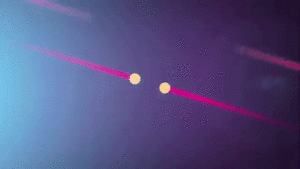You may never have heard of muons before, but these particles are crucial to our understanding of the universe. In a milestone study published in the journal Nature, researchers announced that they have overcome one of the biggest challenges to studying these fundamental particles. The study heralds a new era of research into the properties and structure of matter and that includes us, humans.
Muons are fundamental particles and are very similar to electrons, but 207 times heavier. That means they carry much more energy than electrons. They are crucial to our understanding of our physical world, because they provide information about the properties and structure of matter.
But studying muons is difficult. Fundamental particles like muons (think the neutrino) are only visible at high energies and for microseconds. Physicists have to use particle colliders and accelerators to glimpse their properties. These instruments slam particle beams together at a very high speed and capture data from the resulting explosions, allowing researchers to peek into the subatomic world. This is exactly what physicists have been doing at the Large Hadron Collider, which infamously smashed proton beams together in order to discover and study the theorized Higgs boson, another elusive fundamental particle.
We’d known about muons for many years, but we never managed to put them into a particle accelerator before. Now, after decades of research, Rogers and a team of hundreds of international scientists have outlined how to get closer to creating a first-of-its-kind particle collider that can blast beams of muons at much higher energies than any existing colliders. The invention has the potential to reveal exotic particles that exist only in theory or even entirely new particles scientists had never thought of before.
When you smash beams of particles together, what happens is you make all sorts of exotic new particles, like force carriers or like novel forms of matter, And by looking at all the different sorts of particles which can be created, we can try and understand things about how matter gets stuck together. How matter sticks together is at the basis of our understanding of how everything in the universe is made, because everything is made of matter.
This result is a fundamental landscape change. It doesn’t happen very often. It’s like a Lego piece, to build our future plans. A piece of lego that you can multiply and play with and use to build new things. We can move forward in previously unexplored ways, But a new piece of lego can change how we are going to arrange it.
Despite their obvious importance, colliders like the famous Large Hadron Collider, are massive instruments that cost huge amounts of money and are very hard to build and manage. So far, there is no particle collider designed for muons, which means there is no way of studying and understanding them (even though muons were among the first particles to be ever discovered, in 1936).
For many years the biggest hurdle for studying muons was that we never managed to put them into a particle accelerator. Well, The researchers cracked the problem of “ionization cooling of muons” — basically cooling the smashing beams of particles so they’re easier for current instruments to capture and analyze, rather than having the muons flying all over the place uncontrollably.
The researchers had to develop a technique which can take this messy beam and turn it into a really nice laser-like beam: cooling the beam. So if you imagine the beam is like a hot gas, it’s flying along really fast. What we want to do is reduce the temperature of that gas. The temperature of the muons at production is roughly 10 billion degrees Celsius. We’re trying to go from this diffused gas to something which is more like a laser beam. Cooling techniques have been discovered before, but they usually take minutes or hours to do. What they had developed is a radically different sort of cooling, which can take effect on timescales of billions of a second.
The muon collider itself would be similar in scale to either the Tevatron, which was a machine which was built at Fermilab near Chicago, or the Large Hadron Collider. You’re looking at a machine which is several kilometres in length, with these extremely strong magnets, and the cost scale is similar to those machines.
Muons themselves are interesting beasts and there are applications which we will really only just starting to understand if we start building beyond accelerators. Muons’ properties hint at these future applications. For example, muons are much more penetrating than X-rays, which means they can be used to look inside things that are too thick for x-rays to image. This includes pyramids and volcanoes, for example.
Muons may provide a completely new way to reach further into the energy frontier of particle accelerators that simply cannot be achieved at the present time, and we might not have a way to get there otherwise. But while the study represents a milestone along the road to developing the first-ever muon colliders, don’t hold your breath too soon. There are many more years of research ahead for Rogers’ team to turn this into a reality, he says. But when we do get there, what we find may be truly unimaginable.

